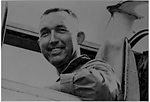
OSCAR MAUTERER - COL
- HOMETOWN:
- gillette
- COUNTY:
- Morris
- DATE OF BIRTH:
- August 24, 1925
- DATE OF CASUALTY:
- February 15, 1966
- BRANCH OF SERVICE:
- Air Force
- RANK:
- COL
- STATUS:
- MIA
- COUNTRY:
- LAOS
Biography
Oscar Mauterer was born on August 24, 1925, in Newark, NJ. His home of record is Gillette, NJ. He graduated from Union High School in 1944.
On November 11, 1950, Oscar entered the US Air Force. After serving in the Army Air Corps as a B-29 navigator during World War II, Oscar graduated from Newark College of Engineering in 1951, and returned to the US Air Force. He got his graduate degree in Astronautics from the Air Force Institute of Technology in 1961.
Major Oscar Mauterer was a pilot of an A-1E aircraft of the 602nd Tactical Fighter Squadron based in Nakhom Phnom Air Base in Thailand. On February 15, 1966, he was flying as a wingman in a flight of two aircraft that were providing cover for two O-1E forward air control (FAC) aircraft five miles south of Na Phao in the Mu Gia Pass area of Khammouane Province, Laos, call sign "Sandy 22". The flight had completed three attack runs and was about to depart the area when he radioed that his aircraft was on fire and he was going to bail out. The flight leader observed a good parachute and circled until it reached the ground near Ban Phopheng, Laos, near the Xe Bangfai river. Search and Rescue (SAR) was notified.
When the flight leader made a low pass to look for Major Mauterer on the ground, the FAC observed ground fire north of Major Mauterer's position. Multiple air strikes were conducted in the area to suppress the hostile fire. Two Jolly Green rescue helicopters arrived on the scene one hour later. On the first attempt to locate and rescue Major Mauterer, one helicopter received ground fire and another air strike was called to suppress hostile fire. Another helicopter approach was made, but the ground fire was too heavy to allow them to hover the area. During this time, there was no visual or radio contact. The only contact was "electronic" (beeper) which could not be identified. Flight leader increased altitude to 3,500 feet to conduct electronic search. Rescue helicopters departed area. SAR reported parachute missing.
On February 17, 1966, a beacon was received on guard channel. Aircraft went to location but beeper was not on long enough to get a lock. Two A-1E aircraft were dispatched to the area where the beeper was heard. One aircraft flew low with an observer with binoculars and the other flew high. Weak beepers were heard on two occasions. Low passes were made by both aircraft with negative visual sightings. No firm fix was possible.
On February 18, 1966, the SAR effort was suspended when no sign of Major Mauterer had surfaced.
On February 20, 1966, a U.S. controlled ground team inserted into the area reported having heard from villagers that an American, correlated to Major Mauterer, was captured by elements of the People's Army of Vietnam.
Another wartime report indicated Lao villagers had carried him from the area on orders of the Vietnam People's Army. Whether that enemy was the North Vietnamese who regularly streamed down the Ho Chi Minh Trail or their Lao communist allies, the Pathet Lao, is a matter for speculation but some reports point to the capture by the Lao.
On July 7, 1966, there was an unconfirmed intelligence report from the villagers of Ban Soy, Khammouan Province, Laos. Villagers told a friendly guerrilla unit that during March 1966, North Vietnamese Army (NVA) soldiers captured the American pilot of an A-1E aircraft shot down in the vicinity of Ban Soy. Villagers reported pilot refused to walk, was carried off by enemy soldiers, and was later sent on foot to North Vietnam accompanied by three guards.
There has not been any evidence to confirm these reports even after numerous investigations by Joint Task Force Full Accounting (JFT-FA) after the war. There is no indication that Major Mauterer ever entered the North Vietnamese Prisoner of War camp system.
Major Mauterer was promoted to Lt. Colonel. He was promoted to Colonel effective August 1, 1971.
Synopsis (from the POW Network) as to the circumstances behind being listed as MIA:
Oscar Mauterer, serving with the 602 Tactical Fighter Squadron Udorn Afld TH, was an A1E aircraft pilot assigned an operational mission in Laos. During the mission, as he was about five miles south of Na Phao in the Mu Gia Pass area of Khammouane Province, Mauterer's aircraft was hit by enemy ground fire and he was forced to eject. Mauterer apparently ejected safely. A parachute was observed and beeper signals were heard, but it was not determined if the signals were those of the pilot. There is reason to believe that he was captured by the enemy. Whether that enemy was the North Vietnemese who regularly streamed down the Ho Chi Minh Trail or their Lao communist allies, the Pathet Lao, is a matter for speculation but some reports point to the capture by the Lao. Mauterer was listed as Missing in Action (MIA) on February 15, 1966.
A September 13, 1968 statement by Soth Pethrasi was monitored from Puerto Rico in which Mauterer's name was mentioned as one of "several dozen captured Airmen." Mauterer was never classified as a Prisoner of War (POW).
During the period he was maintained missing, Oscar Mauterer was promoted to the rank of Colonel (COL)
Since the Department of Defense has not recovered his remains, COL Mauterer remains listed as unaccounted for in Southeast Asia.
Sources: Randy Mauterer (son), POW Network and NJVVMF.
Remembrances
Be the first to add a remembrance for OSCAR MAUTERER
Other heroes from
No other heroes from GILLETTE
Help preserve the legacy of this hero, learn about The Education Center.
LEARN MORE